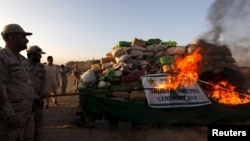The U.N. Office on Drugs and Crime is calling for reform and greater cooperation among regional law enforcement to combat the production of opiates and amphetamine type stimulants across Asia and the Pacific.
The U.N. Office on Drugs and Crime says production and trafficking of illicit drugs, remains at record levels in Asia with up to 10 million users of the drugs as well as prescription stimulants.
Speaking at an Asia Pacific conference of national law enforcement agencies, UNODC regional representative Jeremy Douglas said stimulant use such as methamphetamines continued to rise in most countries in Asia and the Pacific.
“Clearly the supply is as high, if not higher than it has ever been. So indications from every country attending are that it seems to be getting bigger. Possibly with the exception of heroin, which out of Myanmar seems to be like the production of opium is levelling off, but it is still at high levels,” he said.
The UNODC says opiates and amphetamine-type stimulants (ATS) produced in clandestine laboratories remain the two major illicit drug threats in Asia and the Pacific.
In Asia Pacific the transnational crime economy is worth an estimated $100 billion a year, with $30 billion centered on the illicit drug market. Major transnational criminal syndicates are largely behind production of synthetic type stimulants, especially potent in its crystalline form, known as “ice”.
Most methamphetamine laboratories are based in China, where authorities in 2013 shutdown 572 of the illicit operations and where usage continues to rise especially among the young. Other production centers in Asia include Indonesia, Myanmar, Malaysia and the Philippines.
Thailand Justice Minister Paiboon Koomchaya called for greater cross border cooperation to support poor farmers drawn into drug trafficking, and halt the trafficking of precursor chemicals used in illegal drug production.
But Douglas said other challenges lied in implementing reforms.
“They need to drop the barriers between themselves and start working together because the criminals are, they are well out in front, they are truly regional. The law enforcement is not yet regional, the law enforcement is not yet cooperating to the extent if should be regionally,” he said.
The Asia Pacific meeting results are to be presented at a special session of the U.N. General Assembly dedicated to the global drug issue in early 2016.









